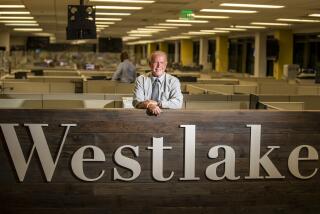A closer look at Mitt Romney’s job creation record
Reporting from Washington —
Shortly after Mitt Romney resigned from Bain Capital in 1999 to run the Olympics in Salt Lake City, potential investors received a prospectus touting the extraordinary profits earned by the private equity firm that Romney controlled for 15 years.
During that time, Boston-based Bain acquired more than 115 companies, according to the prospectus. Bain’s estimated annual returns were more than five times that of the Dow Jones Industrial Average in the same period.
Now a front-runner for the Republican presidential nomination, Romney says his Bain experience shows he knows how to create jobs. He often cites Bain’s investment in a little-known office supply store called Staples, which now employs more than 90,000 worldwide.
DOCUMENT: Read the Bain Capital prospectus
But a closer examination of the prospectus paints a different picture of Bain’s operation. Under Romney’s leadership, Bain became one of the nation’s top leveraged-buyout firms, helping lead a trend in which companies were acquired using debt often pledged against their own assets or earnings.
Bain expanded many of the companies it acquired. But like other leveraged-buyout firms, Romney and his team also maximized returns by firing workers, seeking government subsidies, and flipping companies quickly for large profits. Sometimes Bain investors gained even when companies slid into bankruptcy.
Romney himself became wealthy at Bain. He is now worth between $190 million and $250 million, much of it derived from his time running the investment firm, his campaign staffers have said.
Bain managers said their mission was clear. “I never thought of what I do for a living as job creation,” said Marc B. Walpow, a former managing partner at Bain who worked closely with Romney for nine years before forming his own firm. “The primary goal of private equity is to create wealth for your investors.”
Bain’s top 10 dollar investments under Romney — averaging $53 million — spanned a number of sectors, including healthcare, entertainment and manufacturing. The firm’s largest investment was its 1999 buyout of Domino’s Pizza, into which Bain put $188.8 million, eventually reaping a fivefold return.
Four of the 10 companies Bain acquired declared bankruptcy within a few years, shedding thousands of jobs. The prospectus shows that Bain investors profited in eight of the 10 deals, including three of the four that ended in bankruptcy.
Romney launched Bain Capital in 1984 after seven years at Bain and Co., a highly regarded consulting firm that he joined two years after finishing Harvard Business School. The firm’s founder, Bill Bain, tapped Romney to establish Bain Capital as a separate company that would draw from Bain & Co.’s consulting acumen to buy promising companies and invest in new ones.
According to the prospectus, prepared in late 2000 by a division of Deutsche Bank Securities, investors could participate in Bain’s funds with a minimum investment of $1 million. Bain Capital’s portfolio started with a preponderance of simple investments like Staples, but shifted heavily toward more complex leveraged buyouts and other deals within several years, according to former Bain partners.
Leveraged buyouts allow investors to purchase businesses with the acquisition funded sometimes by significant amounts of debt. To critics, these leveraged deals can make acquired companies more vulnerable to economic downturns, leading to a greater likelihood of bankruptcy and job cuts. At the same time, the deals sometimes introduce discipline to firms and even whole industries that need it.
Either way, Bain investors typically profited.
That was true in the case of GS Industries, the 10th-biggest Bain investment in the Romney years. Bain formed GSI in the early 1990s by spending $24 million to acquire and merge steel companies with plants in Missouri, South Carolina and other states.
Company managers cut jobs and benefits almost immediately. Meanwhile, Bain and other investors received management fees from GSI and a $65-million dividend in the first years after the acquisition, according to interviews with company employees.
In 1999, as economic challenges mounted, GSI sought a federal loan guarantee intended to help steel companies compete internationally. The loan deal was approved, but in 2001, before it could be used, the company went bankrupt, two years after Romney left Bain.
More than 700 workers were fired, losing not only their jobs but health insurance, severance and a chunk of their pension benefits. GSI retirees also lost their health insurance and other benefits. Bain partners received about $50 million on their initial investment, a 100% gain.
“It makes me sick,” said Steve Morrow, a retired GSI steelworker, recalling what happened to his fellow workers after the Kansas City shutdown. Some top managers received bonuses from Bain, he said. “But the salaried and hourly people ended up with the shaft.”
Union officials say they tried to work with GSI management and Bain to assure workers and retirees that they would have some benefits even if the heavily indebted company went under. But they said their appeals fell on deaf ears during and after the time Romney was running the firm.
“Bain was demanding certain financial performance with no understanding of what the problems were on the ground,” said David Foster, a former steelworkers union official who negotiated labor contracts with GSI management from 1994 until the bankruptcy. He said Bain “bled the company,” withdrawing cash for dividends and management fees even as circumstances in the steel industry deteriorated.
“If I were looking for effective management of a project, a company or a country, this is exactly the kind of management I would not want to have,” Foster said of Bain. “Bain partners think the profits they made are a sign of their brilliance. It’s not brilliance. It’s lurking around the corner and mugging somebody.”
Bain declined to comment. But individuals familiar with Bain’s strategy said that the firm had a long-term interest in GSI. They said more than $100 million was invested in improving manufacturing facilities and that the company went bankrupt at a time when more than 40 other steel companies went under, between 1994 and 2004.
A former chief executive of GSI, Roger Regelbrugge, said he admired Bain overall and had high regard for Romney. But he criticized Bain for being too slow to change management priorities and personnel, and he recalled complaining that Bain was extracting annual management fees as the company faltered. About $900,000 in annual fees were paid to Bain through 1999, Romney’s last year at Bain Capital, according to Regelbrugge and filings to the Securities and Exchange Commission.
Romney declined to comment for this story, but in public forums he has brushed aside criticism of Bain’s deals, noting that there were winners and losers in the investment portfolio.
“We didn’t take things apart and cut them off and sell them off,” Romney said in a GOP debate this fall. “We, instead, helped start businesses.... Sometimes we acquired businesses and tried to turn them around, typically effectively. And that created tens of thousands of new jobs.”
But in 2007, during his first run for the presidency, he said he regretted extracting payments from companies that were failing: “It is one thing that if I had a chance to go back I would be more sensitive to,” he told the New York Times.
Romney and his former partners have repeatedly pointed to another, smaller investment in steel that they say offset the GSI case and showed Bain’s overall acumen in backing companies that create jobs.
In 1994 Bain invested $18.2 million in the start-up of a new steel manufacturing company in Fort Wayne, Ind., called Steel Dynamics that is one of the industry leaders in revenue growth. Today that firm reports $6.3 billion in revenue, nearly 25 times the $252.6 million reported when the company went public in 1996, according to Fred Warner, its the company’s investor relations manager. The company now employs more than 6,000 workers, and its sales growth has made it an industry star.
Bain commonly held on to companies for five to seven years, according to interviews with partners and a review of available records. Sometimes, however, Bain invested in a quick flip. It joined another private equity firm in 1996 to purchase Experian, the California-based consumer credit reporting firm. Bain sold the company two months later, reaping $252 million on its initial investment of $88 million, according to the prospectus.
Another example of employment increasing under Bain was Epoch Senior Living, a pioneer in the concept of linking nursing homes and assisted-living apartments. Initially, Bain’s investment in 1998 did not go well. But Bain stuck with Epoch, which had just a few hundred employees. When Bain sold in 2007, investors had more than doubled their initial $26.4-million investment, and Epoch employed more than 3,000.
That wasn’t the case for a medical technology company in California. Bain and affiliated investors purchased the lagging medical diagnostics unit of Baxter International for $448 million in 1994, putting up $26.7 million. It named the new company Dade International.
Under Bain’s direction, Dade acquired a chemicals division of DuPont in 1996 and the diagnostics company Behring in 1997. Dade borrowed big again in 1999, this time to repurchase stock from original investors, Bain and Goldman Sachs, for $365 million, more than four times their original investment, according to the Wall Street Journal.
The growing debt, which hit $1.5 billion, along with declining cash flow and high interest rates, led the company to file for Chapter 11 bankruptcy in 2002 — three years after Romney left Bain. It emerged from bankruptcy after two months and continued to operate. Between 1996 and 2002, the company shed more than 1,700 jobs, according to filings with the SEC.
“When I listen to Mitt Romney these days, he talks about creating jobs. My experience at Dade during those Bain Capital years was that it was strictly an investment, not to create jobs,” said Michael Rumbin, a vice president of technology management at Dade during the Bain years whose position was eliminated in 2000.
“No one came from Bain and said, ‘How can we hire more people?’ ” Rumbin said. “It was, ‘How do we turn our investment around and make a lot of money?’ Which they did.”
More to Read
Sign up for Essential California
The most important California stories and recommendations in your inbox every morning.
You may occasionally receive promotional content from the Los Angeles Times.











